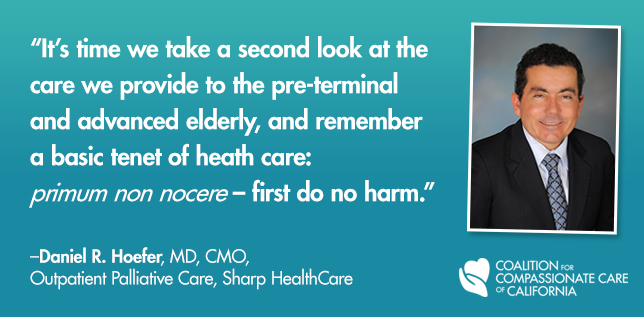As a physician, time and time again I have heard from my peers that prognostication is difficult and unreliable.
But perhaps it is more accurate to say that as physicians, we just aren’t good at it any more. Prognostic education all but disappeared in the 1980s1), perhaps due to the advancement in technologies and scientific discoveries moving our focus to diagnosis and treatment. Most prognostication is now focused on death, and we rarely focus on patient-centered quality outcomes.
I say, it’s time we take a second look at the care we provide to the pre-terminal and advanced elderly, and remember a basic tenet of heath care: primum non nocere – first do no harm.

Consider the following case study and see how you feel at the end of this exercise.
Case Study: Elderly Woman with Arthritic Knee
An 86-year-old woman comes to see you about her left arthritic knee.
- A decade earlier she had a right total knee replacement and did well.
-
The pain in her left knee is responding to low dose routine hydrocodone.
- She did not benefit from steroid injections or viscosupplementation, and she cannot tolerate NSAIDs.
- She has been diagnosed with geriatric frailty syndrome, diabetes, coronary artery disease (CAD) and chronic renal insufficiency.
- She is not demented, has poor vision (even when she agrees to wear her glasses), is hard of hearing, and requires the assistance of her son for groceries, bills and transportation.
- She performs all activities of daily living (ADL), but walks with a cane or walker.
The patient heard that opioids can be bad for you and states that, although medicine controls her moderate pain, she is becoming more fatigued and would like to consider surgery.
Her rheumatologist suggested that a knee replacement was the next step.
Quality of life: Will a knee replacement benefit the patient?
When it comes to patient-centered quality outcomes (PCQOs), this woman is high-risk. Even if the surgery goes well, the patient’s age, functional loss and frailty suggest she does not have the physiologic reserve to survive surgery or hospitalization without high-risk for cognitive and functional decline, institutionalization, and the emotional and financial burdens these issues bring.
Consider the Following Five Things Before Hospitalizing or Operating on Pre-Terminal and Advanced Elderly Patients
They may not be considered the most important outcomes as defined by medical research, but you can bet they are of primary importance to patients.
1. Cognitive Decline
Prognostic modeling shows that this patient has a high-risk for developing hospital-induced delirium (HID)2). HID is shown to be associated with multiple long-term negative outcomes including permanent cognitive decline (e.g., dementia), permanent functional decline, institutionalization, readmission and death. Her prognostic risk for delirium is 63%.
2. Functional Decline
Even if her knee replacement goes well, her risk of permanent functional loss is about 55%3).
Functional loss contributes to the diagnosis of hospital associated disability (HAD)4). HAD is defined as the loss of one ADL such that the patient has to move to a higher level of living. 30% of patients on Medicare discharges over age 70 develop HAD, and of those
- Roughly 41% die within 1 year,
- 30% return to their previous level of function, and
- 29% remain permanently disabled.
It is important to remember that the advanced elderly lose about 5% of their muscle strength per day when bedridden (compared to 1-1.5% of the rest of us), and tend to be hospitalized longer. A frail patient hospitalized for one-week loses one-third of their muscle strength. We should not be surprised if they never walk again.
3. Institutionalization
Because she has frailty syndrome, her length of stay will be nearly twice as long as the average 85-year-old, and her risk of institutionalization increases from 2.9% to 42% (14.5 times higher).5)
Considering the research—which shows that 80% of elderly women would rather die than be institutionalized (even if their hip repair went well)6)—perhaps providers have a moral obligation to forewarn patients of this risk.
4. and 5. Emotional & Financial Burden
One-third of U.S. families lose most or all of their life savings caring for a loved one at the end of life. Since we can predict PCQOs, we should advise patients and families of these potential outcomes before they go down a pathway they may later regret.
Own the Outcomes
As providers we own all of the patient outcomes. The deterioration in quality of life and expense can be immense.
Do you think this woman should move forward with a knee replacement? Why or why not?
Daniel R Hoefer, MD, is Chief Medical Officer of Outpatient Palliative Care for Sharp HealthCare.
References
1. ↑ Christakis, NA, “The Ellipsis of Prognosis in Modern Medical Thought”. Social Science and Medicine 1997; 44(3); 301-15
2. ↑ Inouye, Sharon MD, “Risk Factors for Delirium at Discharge”, Arch Intern Med 2007;167(13)
3. ↑ Sager, Mark MD, et al, “Hospital Admission Risk Profile (HARP); Identifying Older Patients at Risk of Functional Decline Following Acute Medical Illness” JAGS 1996; 44(3); 251-57
4. ↑ Covinsky, KE, et al, Hospital Associated Disability” JAMA 2011;306(16); 1782-93
5. ↑ Makary, Martin A, MD, MPH, “Frailty As a Predictor of Surgical Outcomes” Am Coll Surg 2010; 210(6);901-08;doi;10.1016
6. ↑ Salkeld, G, et al, “Quality of Life Related to Fear of Falling and Hip Fractures in Older Women: A Time Trade-off Study” BMJ 2000; 320(7231);341-46